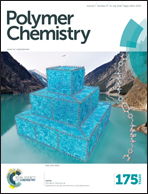Coordination and catalysis of Zn2+ in epoxy-based vitrimers†
Abstract
To elucidate the catalytic action of Zn(II) in the exchange reactions taking place in epoxy-acid vitrimers, extended X-ray absorption fine structure (EXAFS) spectroscopy has been used as well as infrared (IR) spectroscopy on vitrimers. The presence of Zn(II) in vitrimers is revealed by characteristic alterations in both the hydroxide groups and the ester carbonyl bond structures. An EXAFS analysis showed that the zinc cation is coordinated by four oxygen atoms, two of them being negatively charged, i.e. alkoxide groups to satisfy the electroneutrality, whereas IR analysis demonstrated the lengthening of the ester carbonyl bond. The catalytic effect of Zn2+ can be stated as follows: (1) shifting the alcohol/alkoxide equilibrium towards the more nucleophilic alkoxide form; (2) activating the carbonyl bonds by increasing the electrophilicity of the carbon atom; (3) bringing reacting centres close to each other. Zn2+ coordinated in the epoxy-based network therefore appears as a good option to catalyze exchange reactions by transesterification and afford vitrimer properties.

- This article is part of the themed collection: Polymer Chemistry 15th anniversary regional spotlight collection: Europe

 Please wait while we load your content...
Please wait while we load your content...